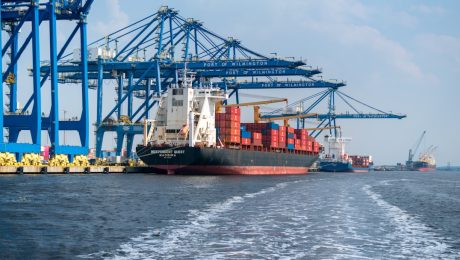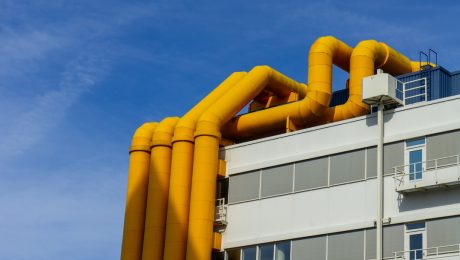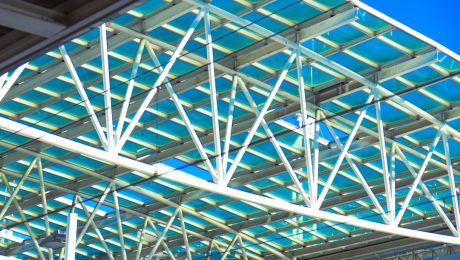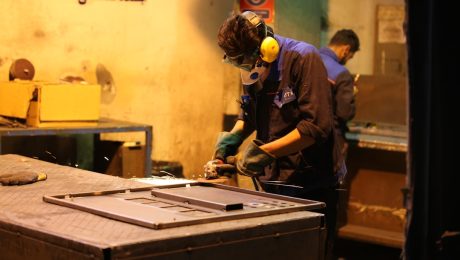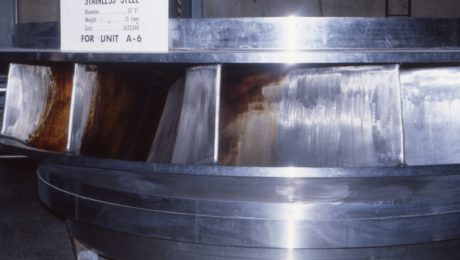In today’s globally interconnected world, efficient logistics are no longer a luxury but a necessity for businesses of all sizes. Successfully navigating the complexities of moving goods requires a deep understanding of both maritime and land logistics, and a strategic approach to seamlessly integrating the two. This post delves into the key strategies for optimizing your supply chain, ensuring timely and cost-effective delivery of your products.
1. Optimizing Port Operations for Efficient Maritime Logistics
The port is the crucial nexus between maritime and land-based transportation. Optimizing port operations is paramount for smooth logistics. This involves several key aspects:
- Strategic Port Selection: Choosing the right port based on factors like proximity to your target market, infrastructure capabilities (cranes, storage facilities), and handling fees is critical. Consider factors like congestion levels and potential delays.
- Container Management: Efficient container handling, including tracking, loading, and unloading, is vital. Implementing technology like RFID tracking can significantly improve visibility and reduce delays.
- Collaboration with Port Authorities: Building strong relationships with port authorities allows for smoother customs clearance processes and proactive problem-solving. Understanding port regulations and procedures is essential.
- Intermodal Connectivity: Seamless integration between ships, trains, and trucks at the port is crucial. Investing in infrastructure and technology that supports intermodal transportation is key to minimizing delays and optimizing costs.
2. Streamlining Land Transportation: From Port to Customer
Once goods arrive at the port, efficient land transportation is critical for timely delivery. This phase involves several crucial elements:
- Choosing the Right Mode of Transport: Selecting the optimal mode of transport (truck, rail, or a combination) depends on factors like distance, cost, delivery speed, and the nature of the goods. Truck transportation offers flexibility, while rail is often more cost-effective for long distances.
- Route Optimization: Utilizing route planning software and GPS tracking can help minimize travel time and fuel consumption. Real-time traffic updates are essential for avoiding congestion and delays.
- Warehouse Management: Efficient warehouse operations, including inventory management and order fulfillment, are critical for quick turnaround times. Implementing warehouse management systems (WMS) can streamline processes and improve efficiency.
- Last-Mile Delivery Optimization: The final leg of the journey, last-mile delivery, often presents significant challenges. Strategies like route optimization, delivery scheduling, and alternative delivery options (e.g., lockers, click-and-collect) can improve efficiency and customer satisfaction.
3. Integrating Technology for Enhanced Visibility and Control
Technology plays a crucial role in modern logistics. Integrating various technologies can significantly improve visibility, control, and efficiency across both maritime and land operations:
- Transportation Management Systems (TMS): TMS software provides a centralized platform for managing all aspects of transportation, from planning and execution to tracking and reporting.
- Global Positioning System (GPS) Tracking: Real-time tracking of shipments provides valuable insights into location, speed, and potential delays, enabling proactive intervention.
- Electronic Data Interchange (EDI): EDI streamlines communication between different stakeholders, such as shippers, carriers, and customs authorities, reducing paperwork and improving efficiency.
- Blockchain Technology: Blockchain can enhance transparency and security by providing an immutable record of all transactions and movements throughout the supply chain.
4. Building Strong Partnerships for Collaborative Logistics
Successful logistics requires collaboration across multiple stakeholders. Building strong partnerships with key players is crucial for efficient and reliable operations:
- Freight Forwarders: Freight forwarders act as intermediaries, managing the complexities of international shipping and customs clearance.
- Shipping Lines: Selecting reliable shipping lines with robust schedules and efficient operations is essential for maritime transportation.
- Third-Party Logistics Providers (3PLs): 3PLs can provide a range of services, including warehousing, transportation, and order fulfillment, freeing up internal resources.
- Customs Brokers: Customs brokers navigate the complexities of international trade regulations, ensuring smooth customs clearance processes.
5. Risk Management and Contingency Planning in Maritime and Land Logistics
Unforeseen events, such as natural disasters, political instability, or port congestion, can significantly disrupt logistics operations. Proactive risk management and contingency planning are essential for mitigating these risks:
- Identifying Potential Risks: Regularly assess potential risks across the entire supply chain, including geopolitical factors, weather patterns, and potential disruptions.
- Developing Contingency Plans: Create detailed plans for handling potential disruptions, including alternative transportation routes, backup suppliers, and emergency communication protocols.
- Insurance and Risk Mitigation Strategies: Secure appropriate insurance coverage to protect against potential losses. Implement strategies to mitigate risks, such as diversifying suppliers and transportation routes.
- Regular Monitoring and Review: Continuously monitor the supply chain for potential risks and regularly review and update contingency plans based on changing circumstances.
By implementing these strategies, businesses can significantly improve the efficiency, reliability, and cost-effectiveness of their maritime and land logistics operations. The key is to adopt a holistic approach, integrating all aspects of the supply chain to create a seamless and optimized flow of goods from origin to destination.
SEO Tags:
- Maritime Logistics
- Land Logistics
- Supply Chain Management
- Logistics Strategy
- Port Operations
In a world increasingly focused on sustainability and reducing waste, the design of long-life steel products is paramount. Creating steel items destined for decades, even centuries, of use requires a meticulous approach that considers material science, manufacturing techniques, and the very essence of enduring design. This post delves into the crucial aspects of designing steel products built to withstand the test of time.
1. Selecting the Right Steel Grade: The Foundation of Durability
The journey to creating a long-lasting steel product begins with selecting the appropriate steel grade. This isn’t a simple matter of choosing the cheapest option; rather, it requires a deep understanding of the product’s intended application and the environmental conditions it will face. Factors to consider include:
- Corrosion Resistance: For outdoor applications or environments with high humidity, choosing a corrosion-resistant steel (e.g., stainless steel) is crucial. Different grades of stainless steel offer varying levels of corrosion resistance, depending on their chromium and other alloying element content. Consider factors like pitting corrosion and crevice corrosion, which can compromise structural integrity over time.
- Strength and Hardness: The required strength and hardness of the steel depend on the product’s function. High-strength low-alloy (HSLA) steels offer a good balance of strength and weldability, while other alloys might be necessary for extreme applications requiring exceptional hardness or impact resistance.
- Weldability: If the product involves welding, the chosen steel grade must be readily weldable without compromising its structural integrity or corrosion resistance. Some high-strength steels can be challenging to weld, requiring specialized techniques and pre- and post-weld treatments.
- Cost-Effectiveness: While longevity is key, the cost of the steel grade must be balanced against its lifespan and the overall cost of ownership. A slightly more expensive, highly durable steel might prove more economical in the long run due to reduced maintenance and replacement costs.
2. Optimized Design for Structural Integrity: Beyond Aesthetics
The design of the steel product itself is critical to its longevity. A poorly designed product, even if made from the highest-quality steel, will fail prematurely. Key design considerations include:
- Stress Analysis: Finite element analysis (FEA) and other computational methods can simulate the stresses and strains the product will experience during its lifetime. This allows designers to identify potential weak points and optimize the design to minimize stress concentrations.
- Fatigue Resistance: Cyclic loading can lead to fatigue failure, even in strong steels. Designing for fatigue resistance involves minimizing stress concentrations, using appropriate surface treatments, and selecting steel grades with high fatigue strength.
- Corrosion Protection: Even corrosion-resistant steels benefit from additional corrosion protection measures. This can include coatings (e.g., paint, powder coating), galvanization, or other surface treatments to prevent corrosion initiation and propagation.
- Modular Design: A modular design allows for easier repair and replacement of individual components, extending the product’s lifespan. This reduces the need for complete product replacement, minimizing waste and environmental impact.
3. Precision Manufacturing: Ensuring Quality and Consistency
The manufacturing process plays a crucial role in determining the quality and longevity of a steel product. Precise manufacturing techniques minimize defects and ensure consistency, leading to improved durability and reliability. Key aspects include:
- Proper Welding Techniques: Welding is a common joining method for steel products. The use of appropriate welding techniques (e.g., gas metal arc welding (GMAW), gas tungsten arc welding (GTAW)) and skilled welders is essential to ensure strong, reliable welds that resist cracking and corrosion.
- Heat Treatment: Heat treatment processes can enhance the strength, hardness, and toughness of the steel. Proper heat treatment is crucial for achieving the desired mechanical properties and ensuring the product’s durability.
- Surface Finishing: Surface finishing processes, such as shot peening or polishing, can improve the fatigue resistance and corrosion resistance of the steel. These processes can also improve the product’s aesthetic appeal.
- Quality Control: Rigorous quality control measures throughout the manufacturing process are vital to identify and rectify defects early on. This ensures that only high-quality products leave the manufacturing facility.
4. Sustainable Material Sourcing and Lifecycle Management: A Holistic Approach
Designing for longevity is not just about the product itself; it also involves considering the sustainability of the entire lifecycle. This includes responsible material sourcing and end-of-life management.
- Recycled Steel: Using recycled steel reduces the environmental impact of steel production, as it requires significantly less energy than producing steel from iron ore.
- Sustainable Manufacturing Practices: Adopting sustainable manufacturing practices, such as reducing energy consumption and minimizing waste, further enhances the environmental credentials of the product.
- Design for Disassembly and Recycling: Designing products for easy disassembly and recycling at the end of their life simplifies the recycling process and maximizes the recovery of valuable materials.
- Extended Producer Responsibility (EPR): Embracing EPR schemes allows manufacturers to take responsibility for the end-of-life management of their products, ensuring responsible disposal and recycling.
5. Testing and Validation: Ensuring Long-Term Performance
Thorough testing and validation are essential to verify the long-term performance of the steel product. This involves subjecting the product to various tests to simulate real-world conditions and assess its durability and reliability.
- Corrosion Testing: Accelerated corrosion tests, such as salt spray testing, can assess the corrosion resistance of the steel and its coatings.
- Mechanical Testing: Tensile testing, impact testing, and fatigue testing evaluate the mechanical properties of the steel and its ability to withstand various loading conditions.
- Environmental Testing: Exposure to extreme temperatures, humidity, and other environmental factors can assess the product’s performance under real-world conditions.
- Long-Term Field Testing: Deploying prototypes in real-world applications allows for long-term monitoring and evaluation of the product’s performance and durability.
By carefully considering these aspects, designers can create steel products that not only meet current needs but also stand the test of time, contributing to a more sustainable and resource-efficient future.
Tags: long-life steel, durable steel products, steel design, sustainable steel, corrosion resistance
Radiographic inspection (RT) is a crucial non-destructive testing (NDT) method used to detect internal flaws in various materials, and its application in pipe inspection is particularly vital for ensuring safety and integrity in numerous industries. From oil and gas pipelines to critical infrastructure, understanding and implementing effective radiographic inspection techniques is paramount. This comprehensive guide will delve into the intricacies of this powerful technique.
Understanding the Principles of Radiographic Pipe Inspection
Radiographic inspection relies on the principle of radiation penetration. A source of ionizing radiation, either X-rays or gamma rays, is directed through the pipe. The radiation passes through the pipe material, with its intensity being affected by the density and thickness of the material. Denser areas, such as welds or material imperfections (e.g., cracks, porosity, inclusions), absorb more radiation, resulting in less radiation reaching the film or detector on the other side. This variation in radiation intensity creates a shadow image, revealing internal flaws that might otherwise be undetectable.
The choice between X-rays and gamma rays depends on factors such as pipe thickness and material. X-rays are generally used for thinner pipes and offer better image resolution, while gamma rays are preferred for thicker pipes and offer greater penetration power. The image produced, whether on film or digitally, is then analyzed by trained personnel to identify and assess the severity of any detected flaws.
Types of Radiographic Techniques Used in Pipe Inspection
Several radiographic techniques are employed for pipe inspection, each tailored to specific situations and pipe geometries. These include:
- Single-wall radiography: This technique examines a single wall of the pipe at a time. It’s suitable for smaller diameter pipes or when focusing on specific weld areas.
- Double-wall radiography: This technique simultaneously inspects both walls of the pipe, providing a comprehensive view of the entire pipe cross-section. It’s particularly useful for larger diameter pipes.
- Panoramic radiography: This technique utilizes a special arrangement of the radiation source and detector to capture a wider area of the pipe in a single exposure. This is efficient for long pipe sections.
- Real-time radiography (RTR): This advanced technique uses digital detectors to provide immediate images, allowing for real-time monitoring and faster inspection processes.
Advantages and Limitations of Radiographic Pipe Inspection
Radiographic inspection offers several advantages, including:
- High sensitivity: RT can detect even small flaws that are often missed by other NDT methods.
- Permanent record: The radiographic image provides a permanent record of the inspection, allowing for future reference and analysis.
- Comprehensive evaluation: It provides a detailed view of internal structures and defects.
- Versatile application: RT can be applied to a wide range of pipe materials and sizes.
However, there are also some limitations:
- Safety concerns: RT involves ionizing radiation, necessitating strict safety precautions and trained personnel.
- Cost and time: RT can be a relatively expensive and time-consuming process compared to other NDT methods.
- Accessibility limitations: Inspection may be challenging in confined spaces or with complex pipe configurations.
- Surface flaws: RT may not effectively detect surface flaws.
Safety Precautions in Radiographic Pipe Inspection
Safety is paramount in radiographic inspection. Strict adherence to safety protocols is essential to minimize radiation exposure to personnel and the environment. This includes:
- Radiation shielding: Proper shielding materials (e.g., lead) must be used to protect personnel from radiation exposure.
- Distance and time: Minimizing time spent near the radiation source and maintaining a safe distance are crucial.
- Personal protective equipment (PPE): Personnel should wear appropriate PPE, including radiation monitoring devices (dosimeters).
- Radiation safety training: All personnel involved in RT must undergo thorough training on radiation safety procedures.
- Regulatory compliance: Strict adherence to all relevant national and international radiation safety regulations is mandatory.
Applications of Radiographic Pipe Inspection Across Industries
Radiographic inspection finds widespread application in numerous industries, including:
- Oil and gas: Inspecting pipelines for welds, corrosion, and other defects to ensure safe and reliable operation.
- Power generation: Inspecting pipes in power plants to detect flaws that could compromise safety and efficiency.
- Chemical processing: Inspecting pipes carrying corrosive chemicals to identify potential leaks or structural weaknesses.
- Construction and infrastructure: Inspecting pipes in buildings, bridges, and other structures to ensure structural integrity.
- Aerospace: Inspecting pipes in aircraft and spacecraft to maintain safety and reliability.
The versatility and accuracy of radiographic inspection make it an indispensable tool in ensuring the safety and longevity of pipe systems across diverse sectors.
Disclaimer: This blog post provides general information about radiographic pipe inspection. Specific procedures and safety regulations may vary depending on location and industry. Always consult relevant regulations and qualified professionals for guidance.
Twisted square wire, with its distinctive strength and aesthetic appeal, is far more versatile than many realize. This robust material finds its place in a surprising array of applications, from intricate crafting projects to robust construction endeavors. This comprehensive guide will delve into the multifaceted world of twisted square wire, exploring its unique properties and uncovering its diverse uses.
1. Crafting and Jewelry Making with Twisted Square Wire
The unique texture and strength of twisted square wire make it a popular choice for artisans and jewelry makers. Its square profile provides a more substantial feel and allows for interesting textural contrasts compared to round wire. Here are some specific crafting applications:
- Wire Wrapping:** Twisted square wire excels in wire wrapping techniques, providing a secure and visually appealing foundation for gemstones and beads. Its rigidity makes it easier to manipulate and create intricate designs.
- Sculpting and Forming:** The square shape lends itself well to sculpting three-dimensional forms. Artists can bend and shape it to create unique pieces of jewelry, decorative elements, or even miniature sculptures.
- Wire Weaving:** Twisted square wire can be incorporated into wire weaving projects, adding texture and strength to the overall design. The square shape allows for interesting interlocking patterns.
- Beaded Jewelry:** The wire’s strength makes it ideal for creating durable beaded necklaces, bracelets, and earrings. It can hold heavier beads securely without bending or breaking.
2. Construction and Industrial Applications of Twisted Square Wire
Beyond crafting, twisted square wire finds crucial applications in various construction and industrial settings. Its high tensile strength and resistance to bending make it a reliable material for numerous tasks:
- Reinforcement:** Twisted square wire is used as reinforcement in concrete and other composite materials, improving their structural integrity and resistance to cracking.
- Fencing and Caging:** Its strength and durability make it suitable for creating robust fences, cages, and enclosures for animals or industrial applications.
- Binding and Bundling:** Twisted square wire is effective for securely binding materials together, such as rebar in concrete construction or bundles of cables.
- Supporting Structures:** It can be used in the construction of supporting structures for various applications, such as trellises for climbing plants or temporary scaffolding.
- Mesh Fabrication:** Twisted square wire is a key component in the creation of various wire meshes used in filtration, screening, and other industrial processes.
3. Choosing the Right Gauge of Twisted Square Wire
The gauge of twisted square wire refers to its thickness. Selecting the appropriate gauge is crucial for ensuring the success of your project. A thinner gauge is suitable for delicate crafting projects, while a thicker gauge is necessary for more robust applications. Consider the following factors when choosing a gauge:
- Intended Use:** Delicate jewelry requires finer gauges, while construction projects need thicker, stronger wires.
- Material Strength:** Higher gauge numbers indicate thinner wire, which is less strong. Lower gauge numbers indicate thicker, stronger wire.
- Desired Aesthetic:** The gauge will influence the overall look and feel of your finished project.
4. Safety Precautions When Working with Twisted Square Wire
While twisted square wire is a versatile material, it’s important to take necessary safety precautions when handling it, especially when working with thicker gauges:
- Wear protective gloves:** This prevents cuts and abrasions from the sharp edges of the wire.
- Use appropriate cutting tools:** Wire cutters specifically designed for metal wire are essential for clean, safe cuts.
- Be mindful of sharp edges:** Handle the wire carefully to avoid injury.
- Wear eye protection:** This prevents potential eye injuries from flying debris during cutting or shaping.
5. Where to Find and Purchase Twisted Square Wire
Twisted square wire is readily available from various sources, depending on your needs and the quantity you require:
- Craft Stores:** Local craft stores often carry smaller quantities of twisted square wire in various gauges, ideal for crafting projects.
- Online Retailers:** Online retailers offer a wider selection of gauges and quantities, often at competitive prices.
- Metal Supply Stores:** For larger quantities or specific industrial applications, metal supply stores are a reliable source.
With its remarkable strength, unique texture, and diverse applications, twisted square wire is a material that deserves a place in every crafter’s and builder’s toolkit. By understanding its properties and uses, you can unlock its full potential and create innovative and durable projects.
Tags: twisted square wire, wire crafting, jewelry making, construction materials, metal wire, wire gauge, DIY projects
body {
font-family: sans-serif;
line-height: 1.6;
}
h1, h2, h3 {
color: #333;
}
img {
max-width: 100%;
height: auto;
}
In the realm of industrial design, the choice of structural elements is paramount. While aesthetically pleasing designs are crucial, the underlying strength and efficiency of the structure are equally vital. Often overlooked, IPN beams (Parallel Flange I-beams) play a significant role in providing robust support and optimal load-bearing capabilities in various industrial applications. This comprehensive guide delves into the world of IPN beams, exploring their characteristics, advantages, and applications within the demanding landscape of industrial design.
Understanding the Anatomy of IPN Beams
IPN beams, also known as parallel flange I-beams, are characterized by their parallel flanges (the horizontal top and bottom sections) and a central web (the vertical connecting section). This distinct shape maximizes their strength-to-weight ratio, making them incredibly efficient for supporting heavy loads. Unlike other I-beam profiles, the parallel flanges of IPN beams simplify design and fabrication processes, especially when it comes to connections and attachments. The dimensions of IPN beams are standardized, allowing for easy selection and calculation of load-bearing capacity. This standardization also contributes to cost-effectiveness and readily available supply.
Material Selection: Steel and Beyond for IPN Beams
While steel is the most common material for IPN beams due to its high strength and durability, other materials are emerging as viable options. Steel’s versatility allows for various grades to be selected based on the specific requirements of the application. Higher yield strength steels offer increased load-bearing capacity, while weathering steels provide enhanced corrosion resistance for outdoor installations. In specialized applications, other materials like aluminum alloys might be considered for their lightweight properties, although they generally offer lower strength compared to steel. The choice of material is heavily influenced by factors like cost, weight restrictions, environmental conditions, and the required lifespan of the structure.
Design Considerations for Optimal IPN Beam Integration
Integrating IPN beams effectively requires careful consideration of several crucial factors. Accurate load calculations are essential to determine the appropriate beam size and material grade to ensure structural integrity. The beam’s span (the distance between supports), the type of load (static or dynamic), and the expected load magnitude all influence the selection process. Furthermore, proper detailing of connections and supports is vital to prevent premature failure. Welded connections are common, but bolted connections offer the advantage of easier assembly and disassembly. Finite Element Analysis (FEA) software can be used for complex designs to simulate stress distribution and optimize the beam placement and sizing.
Applications of IPN Beams in Diverse Industrial Settings
The versatility of IPN beams makes them suitable for a wide range of industrial applications. They are frequently used in the construction of:
- Industrial buildings and warehouses: Supporting roofs, floors, and mezzanines.
- Manufacturing plants: Providing structural support for heavy machinery and equipment.
- Bridges and overpasses: Contributing to the structural integrity of smaller spans.
- Offshore platforms: Used in the construction of supporting structures in demanding marine environments.
- Transportation infrastructure: Supporting elements in railways and roadways.
Their strength and efficiency make them a cost-effective solution for various structural requirements.
Future Trends in IPN Beam Technology and Design
The field of IPN beam technology is constantly evolving. Advancements in material science are leading to the development of stronger and lighter alloys, improving the overall performance of these structural elements. Furthermore, the integration of smart sensors and monitoring systems is enhancing the ability to track the structural health of IPN beams in real-time. This proactive approach allows for timely maintenance and prevents potential failures. The use of advanced computational techniques, such as FEA and machine learning, is also optimizing the design process, allowing for more efficient and sustainable designs.
In conclusion, IPN beams represent a powerful and versatile solution for industrial design challenges. Their strength, efficiency, and ease of integration make them an invaluable component in creating robust and reliable structures. By understanding their characteristics, design considerations, and applications, engineers and designers can harness the full potential of IPN beams to achieve optimal structural performance.
SEO Tags:
- IPN Beams
- Industrial Design
- Structural Engineering
- Parallel Flange I-beams
- Steel Beams
The construction industry is undergoing a significant transformation, driven by the increasing demand for faster, more efficient, and sustainable building solutions. Prefabricated steel buildings are at the forefront of this revolution, offering a compelling alternative to traditional construction methods. This post delves into the exciting innovations shaping the future of prefab steel structures, highlighting their impact on various sectors.
1. Sustainable Steel: Eco-Friendly Prefab Construction
Sustainability is no longer a niche concern; it’s a core requirement for modern construction. Prefab steel buildings are inherently more sustainable than many traditional alternatives. Steel is a highly recyclable material, significantly reducing the environmental impact of demolition and waste disposal. Furthermore, advancements in steel production are continually lowering carbon emissions. Innovations like using recycled steel content in the manufacturing process and employing greener energy sources in steel mills are drastically improving the ecological footprint of these structures. Beyond the material itself, prefab construction minimizes on-site waste, reduces transportation needs (as components are pre-fabricated off-site), and often incorporates energy-efficient design features, leading to lower operational costs and a smaller carbon footprint throughout the building’s lifecycle.
2. Advanced Design & Engineering: Pushing the Boundaries of Steel
Modern software and design techniques are revolutionizing the capabilities of prefab steel buildings. Building Information Modeling (BIM) allows for precise 3D modeling, facilitating seamless integration of various building systems and components. This precision minimizes errors, reduces material waste, and ensures a smoother construction process. Advanced Finite Element Analysis (FEA) software enables engineers to optimize steel structures for strength, durability, and resistance to seismic activity and extreme weather conditions. These sophisticated tools allow for the creation of complex and aesthetically pleasing designs that were previously impossible with traditional steel construction methods. The result is stronger, safer, and more adaptable buildings.
3. Modular Construction & Rapid Deployment: Speeding Up the Build Process
The modular nature of prefab steel construction significantly accelerates the building process. Components are pre-fabricated in a controlled factory environment, minimizing weather delays and on-site disruptions. This modular approach allows for parallel construction activities, further speeding up the timeline. Once the modules are transported to the site, they are assembled quickly and efficiently, often reducing construction time by weeks or even months compared to traditional methods. This rapid deployment is particularly beneficial for projects with tight deadlines, such as temporary housing, disaster relief efforts, and commercial projects where time is money.
4. Smart Steel: Integrating Technology for Enhanced Functionality
The integration of smart technology is transforming prefab steel buildings into intelligent, responsive structures. Sensors embedded within the structure can monitor various parameters, such as temperature, humidity, and structural integrity, providing real-time data for predictive maintenance and energy management. Smart building management systems can optimize energy consumption, improve security, and enhance occupant comfort. This integration allows for greater efficiency, reduced operational costs, and enhanced safety. The ability to remotely monitor and control building systems offers unparalleled convenience and control.
5. Customization & Design Flexibility: Beyond the Standard Steel Box
While historically associated with utilitarian designs, prefab steel buildings are now increasingly customizable. Advances in manufacturing techniques allow for greater design flexibility, enabling architects and builders to create structures that are both functional and aesthetically pleasing. From curved walls and intricate facades to unique roof designs, the possibilities are expanding. The ability to incorporate various finishes, cladding materials, and window systems allows for the creation of buildings that seamlessly blend into their surroundings or make a bold architectural statement. This flexibility caters to a wider range of applications, from residential and commercial buildings to industrial facilities and specialized structures.
The innovations discussed above demonstrate the transformative potential of prefab steel buildings. They offer a compelling solution for meeting the growing demands of a rapidly evolving construction landscape, emphasizing sustainability, efficiency, and design flexibility. As technology continues to advance, we can expect even more groundbreaking innovations in this exciting field.
SEO Tags: Prefab Steel Buildings, Steel Building Construction, Modular Construction, Sustainable Steel Buildings, Smart Buildings
Harnessing the power of the sun is a significant step towards a sustainable future. But the efficiency and longevity of your solar energy system depend heavily on a robust and reliable mounting system. This comprehensive guide explores the diverse world of solar panel mounting, helping you make informed decisions for your specific needs.
1. Understanding the Crucial Role of Solar Panel Mounting Systems
A solar panel mounting system is more than just a way to attach panels to your roof or ground; it’s the backbone of your entire solar energy setup. It provides structural support, ensuring the panels remain securely positioned to optimally capture sunlight throughout their lifespan. A poorly designed or installed system can lead to panel damage, reduced energy production, and even safety hazards. The system’s ability to withstand environmental stresses like wind, snow, and extreme temperatures is paramount. Choosing the right mounting system is crucial for maximizing energy output and ensuring the long-term performance and safety of your investment.
2. Exploring Different Types of Solar Panel Mounting Systems
The type of mounting system you choose depends largely on your specific circumstances, including roof type, panel orientation, and local building codes. The primary categories include:
- Roof-Mounted Systems: These are the most common type, further categorized into:
- Rack Mounting Systems: These use pre-assembled racks that attach directly to the roof, offering flexibility and ease of installation. They are suitable for various roof types, including asphalt shingles, tile, and metal.
- Integrated Mounting Systems: These systems are incorporated directly into the roof during construction, offering a sleek and aesthetically pleasing solution. They are particularly well-suited for new builds or major roof renovations.
- Flashing Mounting Systems: These systems use flashing to seal the panels to the roof, preventing water leakage. They are crucial for maintaining roof integrity.
- Ground-Mounted Systems: Ideal for large-scale solar installations or situations where roof mounting isn’t feasible. These systems utilize ground posts or piles to support the panels.
- Pole-Mounted Systems: These systems use poles to elevate the panels above ground, often used in areas with limited space or where shade is a concern.
- Wall-Mounted Systems: Suitable for mounting panels on the side of a building, often utilized for smaller installations or where roof space is limited. These systems require sturdy wall structures capable of supporting the weight of the panels.
3. Key Factors to Consider When Choosing a Mounting System
Selecting the right mounting system involves careful consideration of several crucial factors:
- Roof Type and Condition: The structural integrity of your roof is paramount. A professional assessment is needed to ensure the roof can safely support the weight of the panels and the mounting system.
- Panel Orientation and Angle: Optimizing the angle of your panels to maximize sunlight exposure throughout the year is critical. The mounting system must allow for adjustments to achieve optimal tilt.
- Local Building Codes and Permits: Compliance with local regulations is mandatory. Check with your local authorities to understand the necessary permits and requirements before installation.
- Environmental Conditions: Wind loads, snow loads, and extreme temperatures significantly impact the design and strength of the mounting system. A system designed to withstand these conditions is essential for long-term reliability.
- Budget: Mounting systems vary widely in cost. Balance your budget with the long-term benefits of a durable and efficient system.
- Aesthetics: While functionality is key, the aesthetics of your solar panel mounting system should be considered, especially for visible installations.
4. Installation Process and Best Practices
Professional installation is strongly recommended. Improper installation can compromise the system’s efficiency, safety, and warranty. A qualified installer will:
- Assess your roof or ground conditions: Ensuring structural integrity and suitability for the chosen mounting system.
- Design and plan the layout: Optimizing panel placement for maximum sunlight exposure and minimizing shading.
- Securely attach the mounting hardware: Using appropriate fasteners and techniques to ensure robust and weather-resistant connections.
- Install the solar panels: Connecting the panels to the mounting system and ensuring proper electrical connections.
- Inspect and test the system: Verifying the system’s functionality and safety before final handover.
It is crucial to choose a reputable installer with experience and a proven track record. Check for certifications and references before making your selection.
5. Maintenance and Longevity of Solar Panel Mounting Systems
Regular maintenance is crucial for prolonging the lifespan of your solar panel mounting system. This includes:
- Visual inspections: Regularly check for loose bolts, corrosion, or signs of damage. Address any issues promptly.
- Cleaning: Keep the system free from debris, particularly in areas prone to dust or snow accumulation.
- Tightening bolts: Periodically tighten bolts to ensure secure connections, especially after extreme weather events.
- Corrosion protection: Apply corrosion-resistant coatings or treatments to protect metal components from rust and degradation.
By following these maintenance practices, you can significantly extend the lifespan of your solar panel mounting system and ensure the continued efficient performance of your solar energy investment.
Choosing the right solar panel mounting system is a critical decision that directly impacts the performance, safety, and longevity of your solar energy system. Careful consideration of the factors discussed above, coupled with professional installation and regular maintenance, will help you maximize your return on investment and enjoy years of clean, renewable energy.
Tags: solar panel mounting, solar mounting systems, roof mount solar, ground mount solar, solar panel installation, solar energy systems
The steel industry is the backbone of countless modern applications, from skyscrapers to automobiles. Ensuring the quality and reliability of steel products is paramount, and this is where ASTM International standards play a critical role. ASTM compliance in steel production isn’t just a matter of ticking boxes; it’s a commitment to safety, performance, and the integrity of the final product. This comprehensive guide delves into the significance of ASTM compliance, exploring its various facets and highlighting its impact on the steel industry.
Understanding ASTM Standards and Their Relevance to Steel
ASTM International (formerly the American Society for Testing and Materials) develops and publishes voluntary consensus standards for materials, products, systems, and services. These standards provide a common language and framework for specifying material properties, testing methods, and acceptance criteria. In the steel industry, ASTM standards are crucial for ensuring that steel products meet specific performance requirements, regardless of the manufacturer or location. These standards cover a vast range of steel types, including carbon steel, alloy steel, stainless steel, and other specialized grades. Adherence to ASTM standards ensures consistency, predictability, and reliability, fostering trust and confidence among manufacturers, suppliers, and consumers.
Key ASTM Standards Used in Steel Production
Numerous ASTM standards are directly relevant to steel production. Some of the most widely used include:
- ASTM A36: This standard specifies the requirements for structural steel for buildings. It defines chemical composition, mechanical properties (tensile strength, yield strength, elongation), and impact testing requirements.
- ASTM A572: This standard covers high-strength low-alloy structural steel, often used in bridges and other high-load applications. It provides detailed specifications for various grades, each with its own unique strength and toughness characteristics.
- ASTM A6: This covers general requirements for steel wire and rod. It outlines tests and requirements for the properties necessary for various applications.
- ASTM E8: This standard outlines the standard method for tension testing of metallic materials, a fundamental test for determining the mechanical properties of steel.
- ASTM A370: This standard details methods and practices for testing metallic materials, encompassing many techniques used in steel quality control.
These are just a few examples; many other ASTM standards address specific steel grades, testing methodologies, and other crucial aspects of steel production.
The Importance of ASTM Compliance in Quality Control
ASTM compliance is integral to a robust quality control system in steel production. By adhering to these standards, manufacturers can:
- Ensure consistent product quality: Standards provide clear specifications, minimizing variations in material properties.
- Reduce defects and waste: Proper testing and adherence to standards help identify and rectify defects early in the production process.
- Improve safety: Meeting specific strength and toughness requirements ensures the structural integrity of steel components, enhancing safety in applications ranging from buildings to bridges.
- Enhance customer confidence: Demonstrating compliance with recognized standards builds trust and confidence with customers.
- Facilitate international trade: ASTM standards are widely recognized globally, simplifying international trade and collaboration.
A comprehensive quality control program will incorporate regular testing and documentation to ensure continuous compliance.
Certification and Accreditation in Relation to ASTM Compliance
Certification and accreditation further strengthen the assurance of ASTM compliance. Independent third-party organizations can audit steel producers to verify their adherence to ASTM standards. These certifications provide an external validation of the manufacturer’s commitment to quality and compliance. Accredited testing laboratories play a crucial role by conducting the necessary tests to ensure that steel products meet the specified requirements. The results of these tests are documented and used to support certification claims.
Consequences of Non-Compliance with ASTM Standards
Failure to comply with ASTM standards can have serious consequences, including:
- Product recalls: If defects are discovered due to non-compliance, it can lead to costly product recalls and reputational damage.
- Legal liabilities: Non-compliance can result in legal action if the non-compliant product causes damage or injury.
- Loss of market share: Customers may lose confidence in a manufacturer who consistently fails to meet quality standards.
- Increased production costs: Corrective actions and rework due to non-compliance can significantly increase production costs.
- Reputational damage: Non-compliance can severely damage a company’s reputation and credibility within the industry.
Therefore, a proactive approach to ASTM compliance is crucial for the long-term success and sustainability of any steel producer.
In conclusion, ASTM compliance is not merely a regulatory requirement but a fundamental pillar of responsible and successful steel production. By embracing these standards, manufacturers can ensure the quality, safety, and reliability of their products, building a strong reputation and contributing to the safety and stability of countless structures and applications worldwide.
SEO-Friendly Tags:
- ASTM Steel Standards
- Steel Quality Control
- ASTM Compliance in Manufacturing
- Steel Material Testing
- ASTM Certification
In today’s technologically driven world, technical guides and manuals are the unsung heroes of efficient operation and user satisfaction. Whether it’s assembling flat-pack furniture, troubleshooting a malfunctioning appliance, or understanding the intricacies of complex software, these documents are crucial for bridging the gap between technology and the user. This comprehensive guide delves into the world of technical guides and manuals, exploring their creation, utilization, and importance in various contexts.
The Essential Elements of a High-Quality Technical Guide
A truly effective technical guide goes beyond simply listing steps. It needs to be clear, concise, and user-friendly. Key elements include:
- Clear and Concise Language: Avoid jargon and technical terms unless absolutely necessary. If used, provide clear definitions. Prioritize simple, direct language.
- Logical Structure and Flow: Information should be presented in a logical sequence, guiding the user through the process step-by-step. Use headings, subheadings, and bullet points to improve readability.
- Visual Aids: Diagrams, illustrations, screenshots, and videos significantly enhance understanding, especially for complex procedures or technical details. High-quality visuals are crucial.
- Troubleshooting Section: A dedicated troubleshooting section anticipates common problems and offers solutions. This proactive approach saves users time and frustration.
- Index and Glossary: These features allow users to quickly locate specific information, enhancing usability and efficiency.
- Accessibility Considerations: Ensure the guide is accessible to users with disabilities, adhering to accessibility guidelines (e.g., WCAG).
Types of Technical Guides and Manuals: A Diverse Landscape
The world of technical documentation is vast and varied. Different products and services require different types of guides. Some common types include:
- User Manuals: These guides provide instructions on how to use a product or service, covering basic operation, features, and safety precautions.
- Installation Manuals: These focus specifically on the installation process, detailing steps, required tools, and potential issues.
- Troubleshooting Guides: These guides address common problems and provide solutions, often in a question-and-answer format.
- Maintenance Manuals: These manuals outline recommended maintenance procedures, ensuring the longevity and proper functioning of equipment.
- Repair Manuals: These detailed guides provide instructions for repairing or replacing components, often including diagrams and schematics.
- API Documentation: For software developers, API documentation explains how to interact with a software application’s programming interface.
Creating Effective Technical Documentation: A Step-by-Step Approach
Creating high-quality technical documentation is a systematic process. It involves careful planning, writing, and review. Here’s a suggested approach:
- Audience Analysis: Identify your target audience and their level of technical expertise. This informs your writing style and the level of detail required.
- Information Gathering: Thoroughly research the product or service, gathering all necessary information from engineers, designers, and other stakeholders.
- Content Outline: Develop a detailed outline that structures the information logically and ensures comprehensive coverage.
- Writing and Editing: Write clear, concise, and accurate content, paying close attention to grammar, style, and consistency. Multiple rounds of editing are crucial.
- Review and Feedback: Obtain feedback from subject matter experts and potential users to identify areas for improvement.
- Publication and Distribution: Choose an appropriate format (e.g., PDF, online help system) and distribute the documentation effectively.
The Importance of Technical Guides in Customer Satisfaction and Product Success
Well-written technical guides are not just helpful; they are essential for customer satisfaction and product success. They:
- Reduce Customer Support Costs: By providing clear instructions and troubleshooting information, guides minimize the need for customer support calls and emails.
- Improve User Experience: Easy-to-understand documentation makes products and services more user-friendly, leading to increased satisfaction and loyalty.
- Enhance Product Safety: Clear safety instructions in manuals can prevent accidents and injuries.
- Boost Brand Reputation: High-quality documentation reflects positively on a company’s professionalism and commitment to customer service.
- Reduce Returns and Refunds: Clear instructions and troubleshooting information can help users resolve problems independently, reducing returns and refunds.
Utilizing and Maintaining Technical Guides: Best Practices
Creating a technical guide is only half the battle. Effective utilization and maintenance are equally crucial. Consider these best practices:
- Regular Updates: Keep your guides up-to-date with the latest product information, addressing bug fixes, new features, and any changes in usage.
- Feedback Mechanisms: Incorporate mechanisms for users to provide feedback, allowing you to identify areas for improvement and address any inconsistencies.
- Accessibility Testing: Regularly test your guides for accessibility, ensuring they are usable by people with disabilities.
- Version Control: Use a version control system to track changes and maintain different versions of your guides.
- Translation and Localization: For global audiences, consider translating your guides into multiple languages to ensure accessibility for a wider user base.
In conclusion, technical guides and manuals are indispensable tools in our technologically advanced world. By understanding their importance, mastering their creation, and implementing best practices for their utilization, businesses and individuals can unlock their full potential, leading to increased efficiency, improved customer satisfaction, and ultimately, greater success.
Tags: technical guides, manuals, technical documentation, user manuals, instruction manuals
Cold drawn flat bars are a crucial component in numerous industries, offering superior precision and mechanical properties compared to their hot-rolled counterparts. This comprehensive guide will explore the intricacies of these versatile steel products, covering their manufacturing process, unique characteristics, diverse applications, and key considerations for selection.
The Cold Drawing Process: Shaping Strength and Precision
Unlike hot-rolled bars, which are shaped at high temperatures, cold drawn flat bars undergo a process of deformation at room temperature. This involves pulling a pre-rolled bar through a series of dies, reducing its cross-sectional area and improving its dimensional accuracy. The process introduces significant tensile stresses, resulting in a refined grain structure and enhanced mechanical properties. This cold working strengthens the material significantly, increasing its yield strength, tensile strength, and hardness. The precise control over the drawing process allows for the creation of flat bars with extremely tight tolerances, crucial for applications demanding high accuracy.
The cold drawing process also improves the surface finish of the bar, resulting in a smoother, more polished surface compared to hot-rolled bars. This smoother surface is less prone to corrosion and can improve the performance of the bar in certain applications, such as those requiring precise machining or assembly.
Exceptional Mechanical Properties: Why Choose Cold Drawn?
The cold drawing process dramatically enhances the mechanical properties of the steel. Cold drawn flat bars boast significantly higher tensile strength, yield strength, and hardness compared to hot-rolled bars. This increased strength translates directly into improved performance in applications requiring high load-bearing capacity and resistance to deformation. The refined grain structure also contributes to improved fatigue resistance, meaning the bars can withstand repeated stress cycles without failure. Furthermore, cold drawing improves the ductility of the material, making it more formable and less prone to cracking during processing.
The specific mechanical properties of a cold drawn flat bar are dependent on the grade of steel used and the degree of cold working applied during the drawing process. Engineers can specify the desired properties to meet the demands of their specific application.
Diverse Applications: Where Cold Drawn Flat Bars Excel
The combination of high strength, precision dimensions, and excellent surface finish makes cold drawn flat bars suitable for a wide range of applications across various industries. These include:
- Automotive Industry: Used in components requiring high strength and precision, such as chassis parts, suspension systems, and engine components.
- Machinery Manufacturing: Ideal for creating machine parts, tools, and fixtures where accuracy and durability are paramount.
- Construction Industry: Used in structural applications requiring high strength and resistance to fatigue.
- Aerospace Industry: Used in components requiring high strength-to-weight ratio and resistance to corrosion.
- Medical Devices: Their precision and biocompatibility make them suitable for certain medical device components.
Selecting the Right Cold Drawn Flat Bar: A Comprehensive Guide
Choosing the appropriate cold drawn flat bar requires careful consideration of several factors:
- Steel Grade: Different steel grades offer varying mechanical properties and corrosion resistance. The choice depends on the specific application requirements.
- Dimensions: Precise dimensions are crucial for many applications. The required thickness, width, and length should be specified accurately.
- Surface Finish: The desired surface finish can impact the performance and aesthetics of the final product. Options range from ground to polished.
- Tolerances: Tight tolerances are essential for many applications, ensuring accurate fitting and assembly.
- Budget: Cold drawn flat bars can be more expensive than hot-rolled bars, so budgetary considerations are important.
Advantages and Disadvantages: A Balanced Perspective
While cold drawn flat bars offer numerous advantages, it’s important to consider their limitations. Here’s a balanced perspective:
Advantages:
- High strength and hardness
- Excellent dimensional accuracy
- Superior surface finish
- Improved fatigue resistance
- Enhanced machinability in certain cases
Disadvantages:
- Higher cost compared to hot-rolled bars
- Limited formability compared to hot-rolled bars
- Potential for residual stresses
By carefully considering the advantages and disadvantages, engineers and manufacturers can make informed decisions about the suitability of cold drawn flat bars for their specific applications.
This comprehensive guide has provided a detailed overview of cold drawn flat bars, from their manufacturing process to their selection criteria. Understanding these aspects is crucial for leveraging the superior properties and versatility of these essential steel products.

